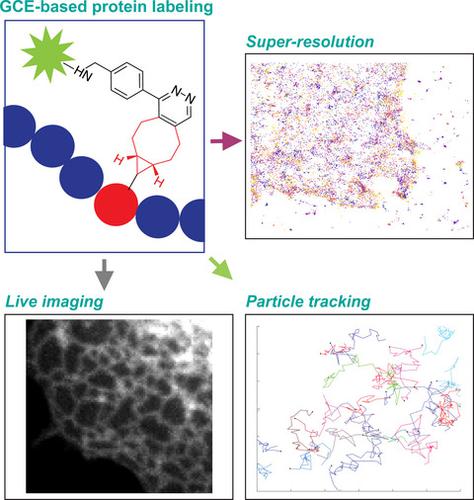Our official English website, www.x-mol.net, welcomes your
feedback! (Note: you will need to create a separate account there.)
Using unnatural amino acids to selectively label proteins for cellular imaging: a cell biologist viewpoint
The FEBS Journal ( IF 5.5 ) Pub Date : 2020-07-08 , DOI: 10.1111/febs.15477 Natalie Elia 1, 2
The FEBS Journal ( IF 5.5 ) Pub Date : 2020-07-08 , DOI: 10.1111/febs.15477 Natalie Elia 1, 2
Affiliation

|
Twenty‐five years ago, GFP revolutionized the field of cell biology by enabling scientists to visualize, for the first time, proteins in living cells. However, when it comes to current, state‐of‐the‐art imaging technologies, fluorescent proteins (such as GFP) have several limitations that result from their size and photophysics. Over the past decade, an elegant, alternative approach, which is based on the direct labeling of proteins with fluorescent dyes and is compatible with live‐cell and super‐resolution imaging applications, has been introduced. In this approach, an unnatural amino acid that can covalently bind a fluorescent dye is incorporated into the coding sequence of a protein. The protein of interest is thereby site‐specifically fluorescently labeled inside the cell, eliminating the need for protein‐ or peptide‐labeling tags. Whether this labeling approach will change cell biology research is currently unclear, but it clearly has the potential to do so. In this short review, a general overview of this approach is provided, focusing on the imaging of site‐specifically labeled proteins in mammalian tissue culture cells, and highlighting its advantages and limitations for cellular imaging.
中文翻译:

使用非天然氨基酸选择性标记蛋白质以进行细胞成像:细胞生物学家的观点
25年前,GFP使科学家首次可视化活细胞中的蛋白质,彻底改变了细胞生物学领域。但是,当涉及到当前最先进的成像技术时,荧光蛋白(例如GFP)由于其大小和光物理性质而受到一些限制。在过去的十年中,已经引入了一种优雅的替代方法,该方法基于用荧光染料直接标记蛋白质,并且与活细胞和超分辨率成像应用兼容。在这种方法中,可以共价结合荧光染料的非天然氨基酸被掺入蛋白质的编码序列中。因此,感兴趣的蛋白质在细胞内进行了位点荧光标记,从而无需蛋白质或肽标记标签。目前尚不清楚这种标记方法是否会改变细胞生物学研究,但显然有潜力这样做。在这篇简短的评论中,提供了这种方法的一般概述,重点是哺乳动物组织培养细胞中位点特异性标记蛋白的成像,并强调了其在细胞成像中的优势和局限性。
更新日期:2020-07-08
中文翻译:

使用非天然氨基酸选择性标记蛋白质以进行细胞成像:细胞生物学家的观点
25年前,GFP使科学家首次可视化活细胞中的蛋白质,彻底改变了细胞生物学领域。但是,当涉及到当前最先进的成像技术时,荧光蛋白(例如GFP)由于其大小和光物理性质而受到一些限制。在过去的十年中,已经引入了一种优雅的替代方法,该方法基于用荧光染料直接标记蛋白质,并且与活细胞和超分辨率成像应用兼容。在这种方法中,可以共价结合荧光染料的非天然氨基酸被掺入蛋白质的编码序列中。因此,感兴趣的蛋白质在细胞内进行了位点荧光标记,从而无需蛋白质或肽标记标签。目前尚不清楚这种标记方法是否会改变细胞生物学研究,但显然有潜力这样做。在这篇简短的评论中,提供了这种方法的一般概述,重点是哺乳动物组织培养细胞中位点特异性标记蛋白的成像,并强调了其在细胞成像中的优势和局限性。







































 京公网安备 11010802027423号
京公网安备 11010802027423号